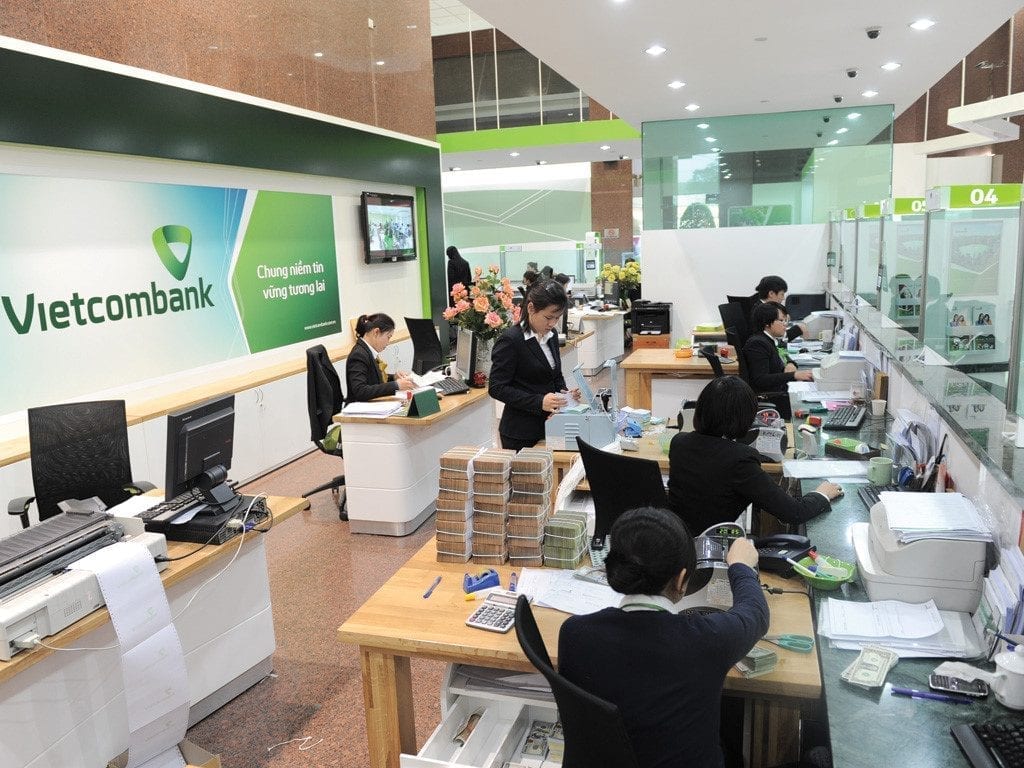
Vietcombank remained the biggest profit earner among lenders in the third quarter, a period in which half of all listed banks saw smaller profits following a race to lure deposits.
Vietcombank made a profit of VND9 trillion (US$375 million) in the third quarter, up 20% year-on-year, followed by MB with VND7.3 trillion, and BIDV with VND5.9 trillion.
Meanwhile, Techcombank reported a profit of nearly VND5.9 trillion, down 12%.
Twenty-seven listed banks have just released their financial statements for the first nine months. Instead of reporting huge profits like they all did over last three years, 14 banks reported smaller profits.
BVBank’s profit dropped by 85% year-on-year to VND60 billion (US$2.5 million), and ABBank’s profit fell from VND1.75 trillion in the first nine months of last year to VND700 billion.
These are the smallest Q3 profits the two banks have earned in five years, mainly due to capital costs increasing more than credit income. ABBank also faced pressure on credit risk provision costs.
VPBank and Eximbank profits were halved, while earnings at VietABank, LPBank, BacABank, VietBank and SeABank dropped by 20% or more.
Less than half of the listed banks enjoyed bigger profits, including Vietcombank (up 18%), BIDV (12%), VietinBank (10%), MB (10%), ACB (11%), HDBank (8%), VIB (7%), Sacombank (54%), MSB (8%), OCB (48%), NamABank (10%) and KienlongBank (25%).
Among the 10 banks with the largest profits, Techcombank, VPBank and SHB saw smaller profits compared with the same period last year.
VPBank ranked 10th with a profit of VND8.3 trillion, compared to third place last Q3 with earnings of VND19.8 trillion. The bank had difficulties with consumer lending and there were no longer any unusual revenues from the re-signing insurance contracts.
Techcombank lost its second ranking, standing in the fifth position after its profit decreased by 18% to VND17 trillion.
SHB’s profit dropped by 8% to VND8.5 trillion.
Vietcombank maintained its first ranking, followed by MB, BIDV and VietinBank.
Banks’ business performance deteriorated a mostly successful race to mobilize capital, which started at end of last year.
SCB’s crisis in October last year, along with the collapse of some U.S. banks, caused increasingly strained liquidity in the banking system.
Last October, the State Bank put SCB under special control after people withdrew money in droves at many SCB branches and transaction offices.
Late last year, banks were concerned with defense and liquidity reserves. This led to a charge to mobilize capital, pushing deposit interest rates up to 11-12% a year at times.
Interest rates quickly cooled down from the second quarter of this year, but the amount of deposits banks mobilized at high interest rates have not yet matured, pushing capital costs up sharply.
Current account savings accounts (CASA), a source of cheap capital for banks, have continuously decreased since the end of last year due to cash flows trending into the savings channel.
The falling stock market, and the dormant real estate and bond markets, also caused people to reduce spending and investment.
In addition, a series of companies withdrew money to serve capital needs and pay financial obligations, including the buying back corporate bonds before maturity.
This series of factors caused the CASA ratio to decline throughout the banking industry.
These factors caused capital costs in the banking industry to skyrocket, with some banks even having to double the expense over the same period last year.
Meanwhile, many banks found it difficult to lend when production and business as a whole slowed down, and the bond and real estate markets froze.
The banking industry’s credit growth by the end of September had only increased 6.92%, figure as low as Covid period nadirs.
Credit balance at many banks also grew at the lowest rate in many years. At BVBank, credit growth by the end of September had reached a mere 4.2%.
This caused credit revenues to not increase at pace with expenses, and income from credit also barely increased or declined.
Securities companies predicted that profit growth of the banking industry would end the year at 10% this year, a meagre showing compared to last year’s growth rate of 30%.

